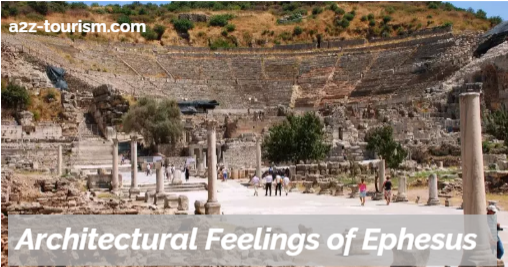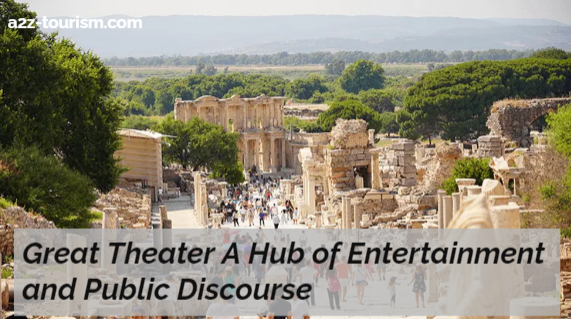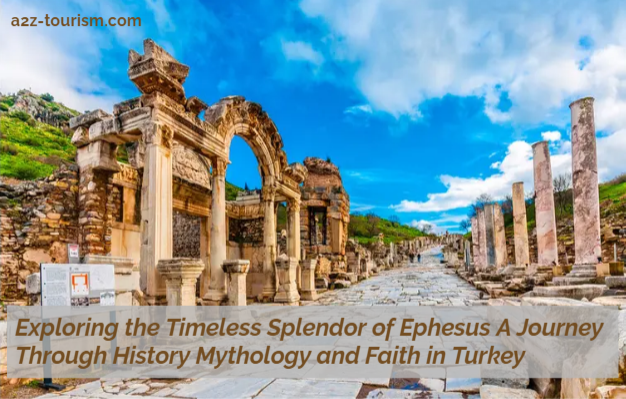Exploring the Timeless Splendor of Ephesus A Journey Through History Mythology and Faith in Turkey nestled along the Aegean seacoast of ultramodern-day- day Turkey lies the ancient megacity of Ephesus, where history, tradition, and church intertwine seamlessly. Ephesus, famed for its extraordinary remnants and archaeological prodigies, occupies a prominent position in both classical history and biblical accounts. From the iconic Library of Celsus to the grand Temple of Artemis, Ephesus stands as a testament to the creativity and cultural sprightliness of ancient societies.
Its part as a mecca of trade, culture, and religion in the ancient world has charmed trippers, scholars, and pilgrims for centuries. In this disquisition, we claw into Ephesus from colorful perspectives, revealing its rich history, emotional depth, and enduring heritage, slipping light on its profound significance and applicability in the contemporary period.
Echoes of Time The Saga of Ephesus
The shade of Ephesus’s history unfurls like the vestments of a grand saga, interlacing the stories of different societies that have indelibly shaped its geography. innovated in the 10th century BCE by Greek settlers from Athens, Ephesus flourished as a bustling megalopolis and a vital mecca of commerce due to its strategic position along the Aegean seacoast. Under the rule of the Lydian and Persian conglomerates, Ephesus continued to thrive, its substance fueled by trade in precious essence, fabrics, and agrarian goods.
Still, it was during the Hellenistic period that Ephesus truly rose to elevation, becoming a center of Greek culture and literacy. During the reign of the Attalid dynasty, the municipality reached its meridian, adorned with magnificent monuments, theaters, and tabernacles.
Yet, Ephesus’s golden age was to be transcended by the rise of the Roman Empire, which adjoined the megacity in 129 BCE. Under Roman rule, Ephesus endured a period of unequaled growth and development, with Emperor Augustus overseeing ambitious construction systems that converted it into one of the conglomerate’s most opulent metropolises.
Despite its outstanding history, Ephesus began to decline in the 3rd century CE, as shifting trade routes and natural disasters led to its gradational abandonment. By the Middle periods, the formerly great megacity had been reduced to a bare shadow of its former glory, its remains serving as a poignant memorial of its fabled history. It wasn’t until the 19th century that Ephesus captured the imagination of the world formerly more, as archaeologists began to uncover its buried treasures and unleash the secrets of its ancient civilization.

Architectural Feelings of Ephesus
Ephesus boasts a fortune of architectural senses, each a testament to the asphalt jungle’s rich history and cultural intention. maybe most famed is the Temple of Artemis, counted among the Seven Prodigies of the Ancient World. Constructed in the 6th century BCE, this grand sanctuary was devoted to Artemis, the megacity’s deified patron goddess, and stood as a mecca of religious veneration and commerce for centuries. Its admiration-inspiring scale and opulent doodads were representational of Ephesus’s substance and influence, drawing pilgrims and callers from far and wide.
Library of Celsus A Testament to Intellectual Achievement
Erected in the 2nd century CE, this magnificent structure housed a sweeping collection of scrolls and calligraphies, making it one of the largest libraries in the older world. Its façade, adorned with statues of Greek and Roman divinities, exemplifies Roman architectural style and artificer, exemplifying the emulsion of Eastern and Western influences that contributed to Ephesus’s artistic sameness.

Great Theater A Hub of Entertainment and Public Discourse
Other notable milestones in Ephesus include the Great Theater, the largest ancient theater in Anatolia, able to seat up to 25,000 observers for performances and public events. The Terrace Houses, a series of opulent places erected into the hillside, give a regard into the diurnal lives of Ephesus’s elite, with their intricate mosaics, oils, and advanced plumbing systems.
Spiritual shrine
Beyond its architectural sensations, Ephesus holds a special place in the hearts of the faithful as a center of religious passage and devotion. For Christians, Ephesus is deified as the final resting place of the Virgin Mary, who’s believed to have spent her last times in a small gravestone house on Mount Koressos, just outside the megacity. moment, the House of the Virgin Mary stands as a sacred point of passage, drawing thousands of devout religionists who come to pay homage to the mama of God and seek her supplication.
Archaeological substantiation confirms the actuality of synagogues and churches within the ancient megacity, emphasizing its different religious heritage. Ephesus stands as a testament to its part as a melting pot of societies and beliefs, where individualities from varied backgrounds and traditions accompanied and engaged with one another harmoniously.
Saving Ephesus’s Cultural Heritage
As guardians of Ephesus’s rich artistic heritage, archaeologists and conservationists shoulder the daunting responsibility of securing its ancient headstones and vestiges for the benefit of unborn generations. Ongoing sweats to save and restore the municipality’s architectural credits are underway, with a focus on stabilizing deteriorating structures, guarding fragile vestiges, and championing sustainable tourism practices.
Ephesus A Regard into the Past
Ephesus, formerly a flourishing Greek and Roman megacity, served as a prominent center of trade, culture, and church in the ancient world. innovated around the 10th century BCE, it gradationally grew into one of the largest metropolises in the Mediterranean region, boasting a population of over 250,000 occupants at its peak. Ephesus flourished throughout its history, attracting and assimilating different societies similar to the Greeks, Romans, and Byzantines, all of whom made significant benefactions to its geography and artistic fabric.
The Magnific Library of Celsus A Testament to Ephesus’ Intellectual Heritage and Architectural Imagination
Among the architectural gems of Ephesus, the Library of Celsus stands altitudinous as a testament to the megacity’s intellectual prowess and intricate design. Constructed in the 2nd century CE, this magnificent library was erected to recognize the Roman assemblywoman Tiberius Julius Celsus Polemaeanus, serving both as a depository of knowledge and as a final resting place for Celsus himself. Despite feeling numerous complaints throughout history, the Library of Celsus remains a bodacious point of Ephesus’ archaeological choreography.
The Enigmatic Temple of Artemis
Conterminous to the bustling thoroughfares of Ephesus formerly stood the majestic Temple of Artemis, one of the Seven prodigies of the Ancient World. devoted to the Greek goddess Artemis, the patron deity of the megacity, the Tabernacle was a colossal phenomenon of armature and religious devotion.
Constructed around the 6th century BCE, the Temple of Artemis passed several phases of expansion and addition, climaxing in a monumental structure adorned with marble columns and sculptural reliefs. Its eventual destruction, first by wildfire in the 4th century BCE and latterly by earthquakes, marked the end of a period, yet the heritage of the Temple of Artemis continues to inspire admiration and seductiveness to this day.
Ephesus A Prominent Setting in Biblical Narratives
Ephesus, a megacity of great significance in the New Testament, holds a prominent place in the missionary expeditions of the Apostle Paul and the spread of early Christianity. According to biblical accounts, Paul visited Ephesus during his alternate missionary trip, where he sermonized in the megacity’s temple and engaged in vigorous debates with original residents and religious leaders. The presence of Ephesus in the biblical narrative is maybe most notable in the Book of Ephesians, a letter attributed to the Apostle Paul and addressed to the Christian community in Ephesus.
Literal Background
The history of Ephesus is as rich and varied as the layers of civilization that have settled upon its soil over glories. innovated around 3000 BCE, Ephesus became an influential megacity under the rule of the Greeks, particularly during the Classical period. During the Hellenistic period, Ephesus flourished under the rule of the Seleucids and latterly the Ptolemies, becoming a center of literacy and culture. still, it was under Roman rule that Ephesus reached its meridian, becoming the capital of the Roman fiefdom of Asia.
Ephesus in Mythology and Religion
In Greek tradition, Ephesus was believed to have been innovated by the Amazon queen Ephesia, giving rise to its name. Artemis, frequently depicted with multiple guts emblematizing fertility, was worshipped fervently by the Ephesians, and her cult attracted addicts from across the ancient world. Ephesus holds particular significance in Christian history as well, as it’s mentioned several times in the New Testament of the Bible. The Apostle Paul spent a considerable quantum of time in Ephesus, sermonizing and establishing the early Christian church there.
Architectural Sensations of Ephesus
Ephesus, a municipality famed for its remarkable architectural heritage, boasts a collection of admiration-inspiring structures that embody its substance and cultural complexity. Among the remnants of Ephesus, several iconic edifices stand out, including the Library of Celsus, the Great Theater, and the Temple of Hadrian, each witching callers with their majesty and beauty.
The Library of Celsus A Symbol of Wisdom and Knowledge
Erected in the 2nd century CE, the Library of Celsus was a depository of thousands of scrolls and served as a symbol of wisdom and knowledge. Its façade, adorned with intricate reliefs and statues, showcases the architectural prowess of the ancient Ephesians, leaving callers in admiration of its majesty.
The Temple of Hadrian A Fusion of Greek and Roman Styles
Devoted to the Roman emperor Hadrian, the Temple of Hadrian stands as another emotional edifice adorned with exquisite puppets and reliefs. It exemplifies the harmonious mix of Greek and Roman architectural styles that characterized Ephesian armature during the Roman period, showcasing the megacity’s artistic and literal significance.
Heritage and Influence of Ephesus
Ephesus, an ancient megacity that endured a decline and eventual abandonment, continues to leave a continuing impact on ultramodern- day society. Despite being in remains, the Church of Ephesus stands as a poignant keepsake to the faith and perseverance of the early Christians who worshipped there. In addition to its nonfictional and religious significance, Ephesus is a symbol of cultural exchange and cross-cultural pollination. Throughout the centuries, this magnificent megacity absorbed influences from a multitude of societies, performing in a vibrant mix of art, armature, and customs that continue to fascinate and inspire.
The Church of Ephesus Today
While the ancient megacity of Ephesus lies in remains, the heritage of its Christian community lives on. Callers to Ephesus can explore the remains of the church, including its basilica, baptistery, and mosaic bottoms, gaining sapience into the religious life of the early Christians who congregated there. Despite centuries of neglect and decay, the spirit of devotion and faith that formerly filled the church still resonates within its worsening walls.
Conclusion
Ephesus stands as an eternal gem in the realm of mortal achievement, interweaving vestments of history, tradition, and church into a witching shade that resonates with all who traipse upon its ancient grounds. From its humble onsets as a Greek trading post to its meridian as a thriving Roman megalopolis, Ephesus bears substantiation to the eclipse and inflow of societies, offering inestimable perceptivity into the rigidity of the mortal spirit and our enduring hunt for meaning over time. As we contemplate the remnants of its grand structures and hear to the echoes of its fabled history, we’re reminded of our participated heritage and the profound interconnectedness that binds us across societies and periods. Ephesus beckons us to claw deeper into its mystifications, to uncover the wisdom it has to conduct and to cherish the heritage it bestows upon us.
Also, Ephesus serves as a poignant keepsake to the flash nature of mortal trials and the enduring power of the mortal spirit to transcend the limitations of time and space. Within its remains, we discover not only fractions of architectural brilliance but also echoes of lives lived within its walls — expedients, dreams, and bournes that have left an unforgettable mark on the annals of history. As we stand amidst the remnants of tabernacles and theaters, we’re invited to contemplate universal themes of faith, rigidity, and the pursuit of verity that resonate across generations and societies. Ephesus, with its mix of myth and reality, invites us on a trip of disquisition and discovery, to uncover the retired trueness that lies buried beneath the beach of time. In doing so, we not only recognize the heritage of Ephesus itself but also fete the continuing spirit of the mortal bid that continues to shape our world to this day.
FAQs
What’s Ephesus notorious for?
Ephesus is notorious for its ancient remains, particularly the well-saved remnants of its Roman and Greek armature, including notable milestones similar to the Library of Celsus, the Temple of Artemis, and the Great Theatre.
Is Ephesus in Turkey or Greece?
Ephesus is located in ultramodern-day- day Turkey, although historically it was part of ancient Greece before coming under Roman rule.
Why is Ephesus important in the Bible?
Ephesus holds significance in the Bible because it’s mentioned multiple times in the New Testament. It was a prominent megacity in Asia Minor and played a significant part in the spread of Christianity. The Apostle Paul visited Ephesus and wrote several letters, including the Letter to the Ephesians, addressing the Christian community there.
What’s Ephesus called moment?
Moment, Ephesus is called” Efes” in Turkish and remains a popular sightseer destination known for its archaeological spots.
Who destroyed Ephesus?
Ephesus didn’t witness a single event or destruction. Throughout its history, it faced ages of decline and destruction caused by factors similar to earthquakes, wars, and shifts in political power.
What was the religion in Ephesus?
During its florescence, Ephesus was primarily associated with Greek and Roman persuasions. The megacity had tabernacles devoted to gods and goddesses similar to Artemis, Athena, and Emperor Augustus. still, Christianity also gained significant influence in Ephesus, particularly after the missionary peregrinations of the Apostle Paul.

